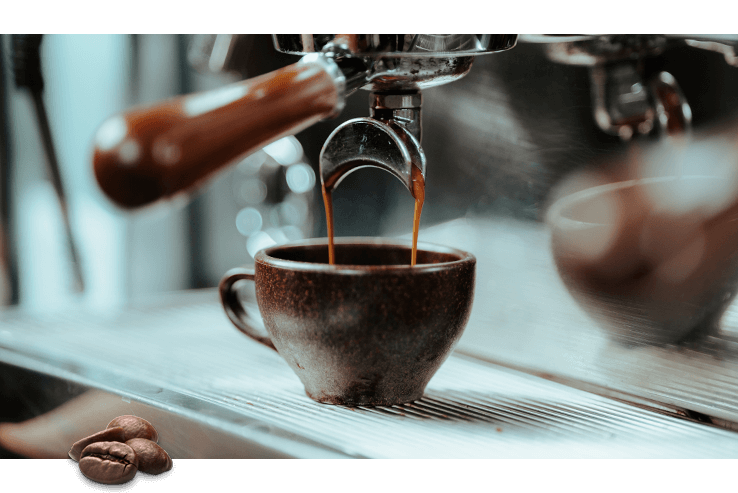SOE Single Origin Espresso – Perfect for Handcrafted Brewing Methods
SOE Single Origin Espresso – Perfect for Handcrafted Brewing Methods
Blog Article
Coffee Beans Uncovered: Uncovering the Secrets of Coffee and Blended Coffee Beans
When you consider coffee, what enters your mind? Is it the rich scent of coffee or the complexity of a well-crafted mix? Understanding the subtleties of coffee beans can transform your experience. Each range, from Arabica to Robusta, holds its own keys. As you discover additionally, you'll uncover how these beans shape tastes and impact sustainability. What might you find concerning your next mug?
The Origins of Coffee: A Historical Point Of View
Although espresso is now a staple in coffee society worldwide, its origins map back to the very early 20th century in Italy. You may be stunned to find out that the invention of coffee was driven by a desire for speed and efficiency. In 1901, Luigi Bezzera patented the first coffee maker, aiming to make coffee faster than standard techniques. This development rapidly captured the focus of Italian coffee drinkers, leading to the coffee bars we recognize with today.
Understanding Espresso Beans: Features and ranges
When you consider coffee, it's important to identify the different bean ranges and their unique tastes. Each kind brings an unique character to your cup, affected by aspects like roast levels. Recognizing these elements can boost your coffee experience considerably.
Coffee Bean Varieties
As you explore the world of espresso, you'll quickly uncover that not all beans are produced equal; each variety brings its own special tastes and attributes to your mug. Arabica beans are understood for their smooth, nuanced tastes and lower caffeine material, making them a favored amongst coffee lovers. Each range provides something different, so experimenting will certainly help you find your best coffee.
Flavor Profiles Clarified
Recognizing the taste profiles of various espresso beans can boost your coffee experience. Each bean variety uses special attributes that influence fragrance, taste, and mouthfeel. For instance, Arabica beans usually offer a sweeter, much more complex flavor with tips of fruit and flower notes, while Robusta beans tend to be bolder, with nutty and natural touches.
When you check out single-origin beans, you may discover distinctive regional flavors-- Main American beans may be brilliant and citrusy, whereas Italian blends commonly deliver abundant, chocolatey notes.
Roast Degrees Influence
Roast degrees play a crucial duty in forming the flavor and aroma of coffee beans, affecting your general coffee experience. Recognizing these roast levels helps you pick the coffee that fits your preference preferences. Exploring with various roasts can lead to fascinating explorations, improving your admiration for coffee.
The Art of Blending: What Makes Blended Coffee Unique
What makes combined coffee so fascinating? It's everything about the art of integrating beans from various beginnings, roast levels, and taste profiles. You're not just mixing; you're producing an unified balance that highlights the toughness of each bean when you blend. You can explore different combinations to enhance sweet taste, level of acidity, and body, leading to a brew that's richer and much more complicated than a single-origin coffee.
Mixing likewise permits you to cater to diverse preference choices. You can craft a blend that's smooth and smooth or one that's strong and durable, relying on your audience. And also, mixing can help keep uniformity, providing a reliable taste experience no matter of seasonal variants in beans. So, whether you're a home or a barista maker, mastering the art of blending opens up a globe of creativity and taste opportunities, making your coffee experience really one-of-a-kind - SOE.
Taste Accounts: Tasting Notes of Coffee vs. Blended Coffee
Mixed coffee offers a globe of taste possibilities, but when it concerns espresso, you're checking out a more focused experience. Coffee usually showcases bold, rich flavors with a thicker mouthfeel. You could notice notes of dark chocolate, sugar, or perhaps hints of fruit, relying on the beans. The strength can be both satisfying and invigorating.
On the other hand, mixed coffee offers a complex tapestry of flavors. You can discover a range of tasting notes, from sweet and nutty to flower and fruity. Each blend can use something special, typically combining beans from various areas to create a balanced profile.
While espresso provides a punch, mixed coffee welcomes you to enjoy the nuances. Whether you favor the robust stamina of coffee or the detailed flavors of mixed coffee, each mug informs its very own story, waiting on you to find.
Developing Techniques: Refining Your Espresso Shot
To achieve the perfect espresso shot, understanding the brewing strategies is essential, as even minor changes can considerably influence the taste and quality. Start by utilizing fresh, high-quality coffee beans; grind them just before brewing for optimum flavor. Objective for a fine work, regarding the consistency of common salt, to assure perfect extraction.
Next, take note of your water temperature; it needs to be between 195 ° F to 205 ° F. Too too cool or hot can ruin your shot. Usage concerning 18-20 grams of coffee for a double shot, and tamp it evenly with solid pressure to produce a consistent puck.
A longer extraction can lead to bitterness, while as well short can result in sour flavors. Practice these techniques regularly, and you'll refine your abilities, achieving that rich, robust espresso shot you long for.
The Role of Roast Degrees in Espresso and Blended Coffee
After grasping the brewing techniques for espresso, it's time to ponder just how roast levels influence the taste profile of your coffee. The roast level can significantly modify your espresso's body, preference, and scent. Light roasts have a tendency to highlight the coffee's beginning, using intense level of acidity and fruity notes, while tool roasts balance level of acidity and sweet taste, producing an all-round taste. Dark roasts, on the other hand, draw out vibrant, rich their explanation flavors with lower acidity, commonly generating delicious chocolate or smoky undertones.

Discovering Sustainability: Honest Sourcing of Coffee Beans
When you select coffee, you're not just picking a taste; you're deciding concerning the effect on farmers and the atmosphere. Understanding Fair Trade practices, chemical-free farming techniques, and accreditation requirements can aid you support sustainable coffee sourcing. Let's check out exactly how these elements contribute to a more moral coffee experience.
Fair Profession Practices
Fair Trade practices play an essential duty in making sure that coffee beans are sourced ethically and sustainably. You support farmers that get reasonable salaries and job in safe problems when you pick Fair Profession coffee. This commitment to moral sourcing assists fight destitution and promotes neighborhood advancement in coffee-growing regions. You'll locate that Fair Trade certification likewise motivates eco-friendly farming practices, as producers are incentivized to secure their land and sources. By going click here for info with Fair Profession brand names, you're not just appreciating a rich mug of coffee; you're making a favorable influence on the lives of those who grow it. Your option issues, and it connects you to a worldwide motion concentrated on justness and sustainability in the coffee industry.
Natural Farming Approaches
As you check out the world of ethical coffee sourcing, natural farming methods arise as a vital part of sustainability. Furthermore, it frequently leads to stronger, much healthier coffee plants, resulting in richer flavors in your mug. When you choose for natural coffee, you're making a conscious option that profits both the earth and your taste buds.
Certification Criteria Explained
Recognizing certification requirements is important for any individual interested in fairly sourced coffee. These criteria, such as Fair Trade, Jungle Partnership, and USDA Organic, warranty that coffee is grown under sustainable techniques. You sustain farmers who adhere to honest labor techniques and environmental protection. when you choose accredited coffee.
Fair Profession certification concentrates on providing fair earnings and functioning problems, while Rain forest Partnership stresses biodiversity and ecosystem preservation. USDA Organic ensures that no synthetic fertilizers or pesticides are news utilized. By acquainting on your own with these accreditations, you can make enlightened selections that straighten with your worths. Following time you go to your neighborhood café or food store, try to find these tags, and really feel excellent knowing your coffee purchase positively impacts neighborhoods and the setting.
Frequently Asked Inquiries


Exactly How Does Altitude Affect the Development of Coffee Beans?
Elevation effects coffee bean growth by affecting temperature level and environment. Greater elevations usually generate denser beans with even more facility tastes, while reduced altitudes can result in faster development however less savory results. You'll taste the distinction!
What's the Difference In Between Arabica and Robusta Beans?
Arabica beans are sweeter and much more intricate, while Robusta beans have a stronger, harsher taste with higher high levels of caffeine content. You'll locate Arabica chosen for specialized coffees, whereas Robusta's typically used in immediate coffee and espresso blends.
Can Coffee Beans Spoil or Lose Flavor Over Time?
Yes, coffee beans can go negative and lose taste in time. If you save them incorrectly or maintain them too long, they'll come to be stale. Constantly maintain your beans in an impermeable container away from light and dampness.
What Are the Health Benefits of Drinking Coffee?
Drinking espresso increases your power, enhances mental clearness, and might lower the risk of specific conditions. It's abundant in antioxidants, supports metabolic rate, and can improve mood, making it a valuable choice for your everyday regimen.
Just How Does Water Top Quality Impact Espresso Extraction?
Water high quality greatly impacts espresso removal. It influences the solubility of oils and flavors, affecting preference and aroma. Utilizing filtered water can boost your coffee, guaranteeing a balanced and enjoyable cup each time you make.
Coffee Beans Uncovered: Uncovering the Keys of Espresso and Blended Coffee Beans.
Comprehending the flavor profiles of different espresso beans can elevate your coffee experience.Roast degrees play an important role in shaping the flavor and fragrance of coffee beans, affecting your general coffee experience (SOE).Mixed coffee provides a world of flavor possibilities, yet when it comes to coffee, you're looking at an extra concentrated experience.After grasping the brewing techniques for coffee, it's time to ponder just how roast degrees affect the taste profile of your coffee
Report this page